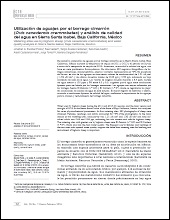Utilización de aguajes por el borrego cimarrón (Ovis canadensis cremnobates) y análisis de calidad del agua en Sierra Santa Isabel, Baja California, México
Watering sites use by bighorn sheep (Ovis canadensis cremnobates) and water quality analysis in Sierra Santa Isabel, Baja California, Mexico
Author
JONATHAN GABRIEL ESCOBAR FLORES
SERGIO ALVAREZ CARDENAS
SARA CECILIA DIAZ CASTRO
ARADIT CASTELLANOS VERA
Jorge Torres Rodriguez
MARIANA DELGADO FERNANDEZ
Metadata
Show full item recordAbstract
"Se analizó la utilización de aguajes por el borrego cimarrón en la Sierra Santa Isabel, Baja California, México durante la temporada de sequía de 2011 y 2013 y el periodo de lluvias e inicio de la temporada de sequía del 2015. Asimismo, se estudió la calidad del agua, con base en siete parámetros fisicoquímicos. Se obtuvieron 260 registros fotográficos de borregos cimarrones, donde hembras, añeros y corderos representaron el 73%. En el periodo de lluvias, en dos de los aguajes se obtuvieron valores de conductividad de 1.31 µS/cm2 y 1.92 µS/cm2, y de sólidos disueltos totales de l0.65 ppt y 0.95 ppt, indicando un bajo contenido de sales en el agua. Los valores de oxígeno disuelto mayores a 6.4 ppm, dureza del agua menor a 100 ppm y PH entre 6.5 y 8.5, sugieren que el agua tiene condiciones óptimas para ser bebida por los borregos cimarrones. Los aguajes con mayor utilización por los borregos fueron El Zamora (n = 120) y El Cordero (n = 67), donde se registraron las mejores condiciones de calidad de agua en este estudio. El mayor registro de hembras y añeros, asociado a condiciones óptimas de calidad del agua, confirman la importancia de los aguajes para la crianza y reclutamiento del borrego cimarrón." "Water used by bighorn sheep during the 2011 and 2013 dry seasons and the rainy season and drought of 2015 in the Sierra Santa Isabel of the State of Baja California, Mexico was analyzed for seven physicochemical parameters. At four watering sites, 260 photographs of sheep were obtained. Females, yearlings, and lambs accounted for 73% of the photographs. In the rainy season at two watering sites, conductivity was 1.31 µS/cm2 and 1.92 µS/cm2 and total dissolved solids was 0.65 and 0.95 ppt, indicating low salt content and safe for bighorn sheep. The watering sites with greater use by bighorn sheep were El Zamora (n = 120) and El Cordero (n = 67), which also had the best water quality. The frequent use by females and yearlings of the two sites with optimal water quality support the belief that watering sites for lambing and recruitment of bighorn sheep is important."
Collections
Related items
Showing items related by title, author, creator and subject.
-
PROMOCIÓN DEL PERIFITON PARA EL CULTIVO DE CAMARÓN BLANCO: HACIA UNA ACUICULTURA ECOLÓGICA
DOMENICO VOLTOLINA LOBINA; JUAN MANUEL AUDELO NARANJO; MARIA DEL ROSARIO PACHECO MARGES -
Suelo y Erosión
YOLANDA LOURDES MAYA DELGADO


